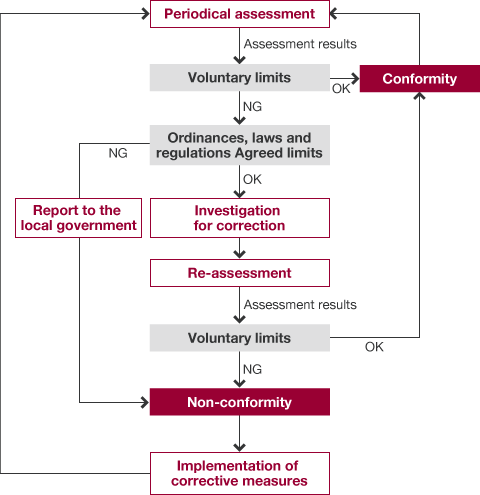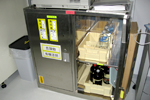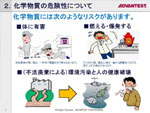 網站內容顯示
網站內容顯示

Basic policy for environmental risk management
the Advantest Group sets voluntary standards more stringent than prevailing environmental laws and regulations, and implements such standards in the course of operating equipment that could potentially impact the environment, and in monitoring and assessing those operations.
Furthermore, to ensure that we respond without hesitation should an environment-related incident occur, we have forged rules for addressing such risks, stipulated in documented operating procedures and chemical substance emergency-response procedures and other such guidelines, and have put management systems in place related to those rules.
Moreover, our employees and contractors handling particularly high risk operations regularly take part in specialized training and emergency drills, conducted to ensure that they are able to act swiftly in the event of an emergency.
Business location compliance management

Basic policy for chemical substance management
We are working to ensure safety management and compliance with laws and regulations in the use and storage of chemical substances used at business locations at the Advantest Group.
To this end, we have adopted a chemical substance management system. Based on this system, chemical substances are registered, safety reviews are conducted, design that supports input/output control and laws and regulations is adopted, and the material safety data sheets (MSDS) that are necessary for the safe handling of chemical substance have been made available for inspection at any time.
In addition, for strengthened risk management and chemicals substance management, we are constructing a safety training system, and conducting audits and providing guidance through the corporate chemical management division to ensure the safety of stored chemical substances to further enhance our safety control system.
Furthermore, we plan to build up our global management system as we aim to achieve the same level of risk management overseas as in Japan.
Ramping up chemical substance controls
Pursuing higher control precision

Stringent chemical controls

Controls applied to each and every container
In implementing its systems for ensuring proper management of chemical substances, the Advantest Group applies container-level controls on chemical elements handled in the course of operations. Moreover, we pursue flexible practices in this regard through a process that involves first assigning substances to different control rankings on the basis of control levels required for respective substances under the Pollutant Release and Transfer Registers (PRTR Act), the Poisonous and Deleterious Substances Control Act, the Industrial Safety and Health Act, and other such laws and regulations, and then establishing different control methods for each respective ranking.
Adopting chemical control methods more precisely aligned with potential risks
In fiscal 2012, the Advantest Group implemented general training on chemicals for all employees to ensure that knowledge about chemical handling and related cautionary points would spread throughout the Company. On confirming this result in fiscal 2013, we simplified control methods for chemicals deemed to pose little risk. For low-risk chemicals used in small amounts, as well as commercially available sprays and glues, we introduced a new Rank 0, which allows each employee to manage the substances as they see fit.
Chemical substance control rankings
| Rank | Conditions for application | Locked storage | Dispensary control | Inventory checks |
|---|---|---|---|---|
| 4 | Chemical is extremely toxic or has a profound social impact; registration with national or other government is necessary. Examples: narcotics, stimulants, etc. | Yes | Yes | As required by law |
| 3 | Chemical is highly toxic; any loss must be reported. Examples: poisons, strong drugs, etc. | Yes | Yes | Monthly |
| 2 | Chemical is inflammable, corrosive, or poisonous with prolonged exposure. Examples: organic solvents, acids, alkalis, etc. | Yes | Yes | Twice annually |
| 1 | Chemical is not very harmful, but due to the large amounts used, control is necessary. Examples: solder paste, Fluorinert, etc. | No | Yes | Twice annually |
| 0 | Chemical is not very harmful and does not warrant special control. Examples: some adhesives, grease, lubricants, paint, lead-free solder, wire solder , bar solder, sprays (spray oil, cooling spray), etc. | No | No | No |
General and specialized education on chemical substances by e-learning

Materials used in training
on chemical substances
In addition to the general training on chemical substances that we began administering in fiscal 2012, the specialized training for employees who handle chemicals on a daily basis was moved from the classroom to e-learning in fiscal 2013.
General training on chemical substances aims to impart to all employees the knowledge that even familiar chemicals can, if handled improperly, cause unforeseen accidents or pollute the environment, and how to reduce those risks. On the other hand, specialized training is aimed at employees who use chemicals on a daily basis. They get practical instruction in the risks posed by some chemicals and how to handle those chemicals safely. Administration of this program via e-learning widened participation and made it possible for all supervisory personnel to take part.
The specialized training on chemical substances deals with the main chemicals subject to legal regulation, such as strong poisons and medications, organic solvents, specified chemical substances, and designated hazardous materials under the Fire Defense Law. Examples of accidents are given and explained in a straightforward way.
Content
- The danger of chemical substances (effect on the human body)
- The importance of safety training for chemical handlers
- The importance of wearing protective materials (gloves, goggles, masks, etc.)
- Points to be observed according to the law
Special medical diagnosis, selection of a work leader, environmental measurement, inspection of ventilation equipment, notification of designated hazardous materials under the Fire Defense Law


